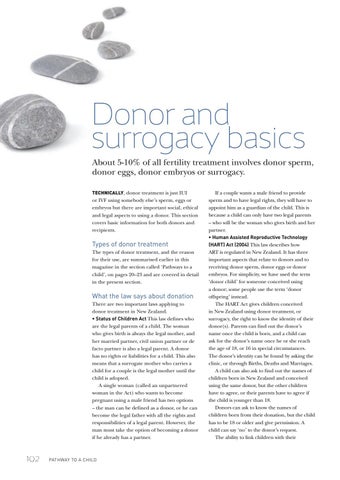Donor and surrogacy basics About 5-10% of all fertility treatment involves donor sperm, donor eggs, donor embryos or surrogacy. TECHNICALLY, donor treatment is just IUI or IVF using somebody else’s sperm, eggs or embryos but there are important social, ethical and legal aspects to using a donor. This section covers basic information for both donors and recipients.
Types of donor treatment The types of donor treatment, and the reason for their use, are summarised earlier in this magazine in the section called ‘Pathways to a child’, on pages 20–23 and are covered in detail in the present section.
What the law says about donation There are two important laws applying to donor treatment in New Zealand. • Status of Children Act This law defines who are the legal parents of a child. The woman who gives birth is always the legal mother, and her married partner, civil union partner or de facto partner is also a legal parent. A donor has no rights or liabilities for a child. This also means that a surrogate mother who carries a child for a couple is the legal mother until the child is adopted. A single woman (called an unpartnered woman in the Act) who wants to become pregnant using a male friend has two options – the man can be defined as a donor, or he can become the legal father with all the rights and responsibilities of a legal parent. However, the man must take the option of becoming a donor if he already has a partner.
102
PATHWAY TO A CHILD
If a couple wants a male friend to provide sperm and to have legal rights, they will have to appoint him as a guardian of the child. This is because a child can only have two legal parents – who will be the woman who gives birth and her partner. • Human Assisted Reproductive Technology (HART) Act (2004) This law describes how ART is regulated in New Zealand. It has three important aspects that relate to donors and to receiving donor sperm, donor eggs or donor embryos. For simplicity, we have used the term ‘donor child’ for someone conceived using a donor; some people use the term ‘donor offspring’ instead. The HART Act gives children conceived in New Zealand using donor treatment, or surrogacy, the right to know the identity of their donor(s). Parents can find out the donor’s name once the child is born, and a child can ask for the donor’s name once he or she reach the age of 18, or 16 in special circumstances. The donor’s identity can be found by asking the clinic, or through Births, Deaths and Marriages. A child can also ask to find out the names of children born in New Zealand and conceived using the same donor, but the other children have to agree, or their parents have to agree if the child is younger than 18. Donors can ask to know the names of children born from their donation, but the child has to be 18 or older and give permission. A child can say ‘no’ to the donor’s request. The ability to link children with their
